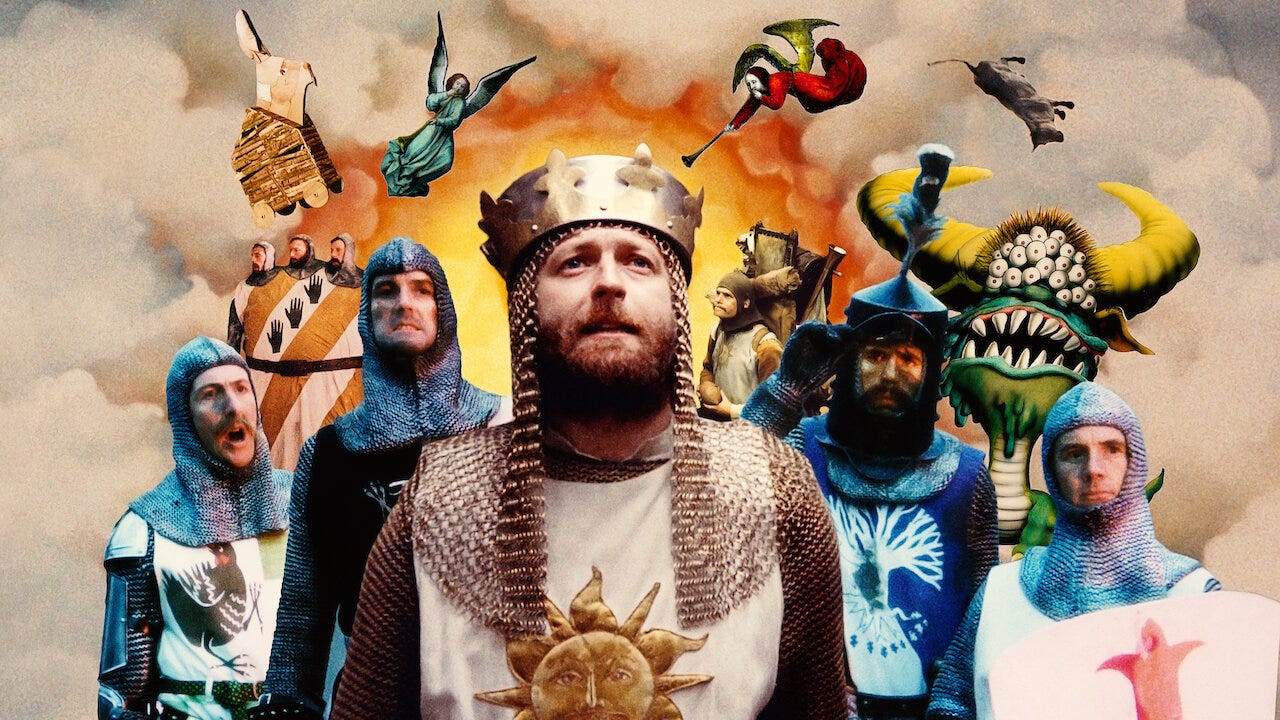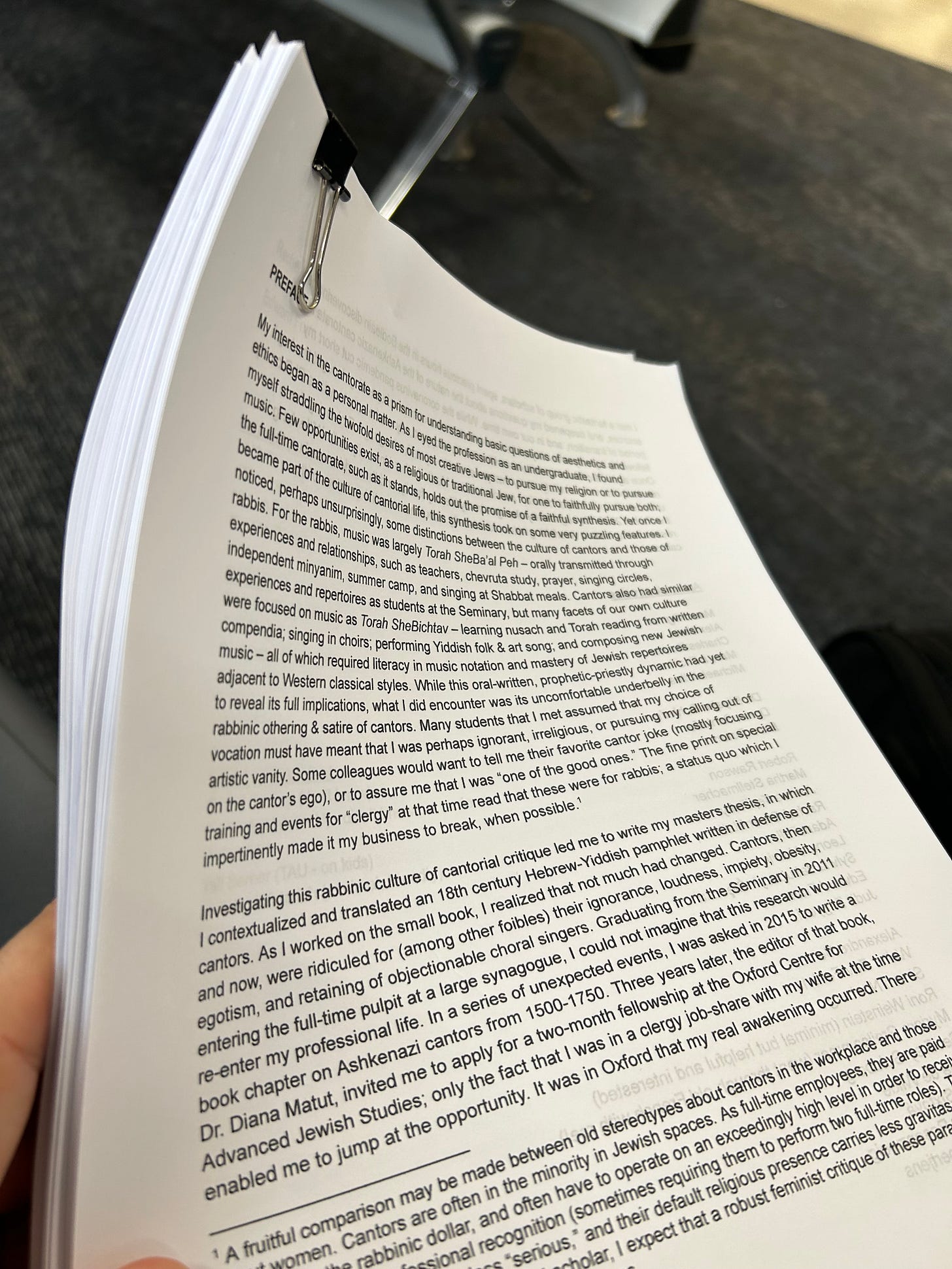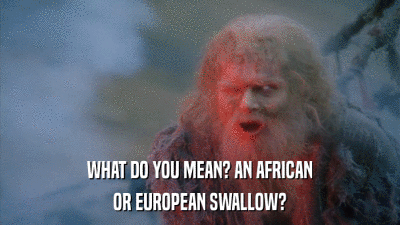UK Tour & PhD Update
An Anglo-Jewish Adventure next June, and views of an academic mural (unfinished)
I remember ten-year old me sitting in my best-friend’s basement as Arthur—son of Uther Pendragon, from the castle of Camelot, King of the Britons, defeater of the Saxons, Sovereign of all England—began to debate with a far aloft castle guard about the airspeed velocity of an unladen swallow.
I’m not sure what was in the popcorn we enjoyed that evening, but this was the beginning of a lifelong passion for British humor, and ultimately British culture. My passion for Monty Python reached a savant-level in my teenage years, as I devoured the entire Python canon and any book, movie, TV-special, musical, recording, or media ever produced by the fab six (I even maintained a Python-themed website on that blessed web hosting platform of yore, Geocities).
But as I was mastering the comic and remissive aspects of British culture, I was also learning its disciplines and canons. I began my Shakespeare studies as a middle-schooler, and became hooked on Renaissance drama after a magical summer as a theater camper at the American Shakespeare Center. The rich language and philosophical depth of the Bard delighted my mind and satisfied my penchant for acting. In my early college days, I thought that I would grow up to be either an English teacher or a professional cellist. Though I became a cantor instead, my interest in the ways of Albion never abated.
Over the last decade, my professional life as a Jew and my youthful interest in British culture have continued to intertwine. At the synagogues I served, I developed a series of Jewish Shakespeare weeks for teens and adults. These brought together the textual analysis skills required for Torah study with those required for analyzing plays, as well as bringing both canons into conversation about big topics (of course we would see a Shakespeare play as well). I started teaching online at a Britain-based Jewish liturgy school and working with a British cantorial association.
But the real highlight of my Anglo-Jewish journey was in January of 2020, when I spent two months on a Jewish Studies research fellowship at Oxford University. In those hallowed halls of learning (some of which were the sets and backdrops of the Harry Potter movies), my days were filled with reading books and manuscripts, engaging with major scholars of Jewish music from across the world, and seeing amazing music and theatre in the evenings. Though bookended by the COVID-19 pandemic, these two months set me on the path towards my doctoral pursuits, and led to many great friendships and experiences in England.
Three years later, I am ready to return and share the best of Britain’s Jewish cultural and musical treasures with all who will join me. This sacred music, history and cultural tour of Jewish Britain will run next June 18-28, 2024.
I’ve done large musical missions abroad before — this is much more intimate and focused on its theme. While there will be a pre-tour of London highlights and a post-tour Shabbat in the Beatles’ hometown of Liverpool, the core tour is focused on musicology, Anglo-Jewish history, great concerts, and gatherings with local Jewish communities and institutions, including New London Synagogue, New North London Synagogue, Belsize Square Synagogue, JW3, and Leo Baeck College. The trip will feature unique stories and sites of Anglo-Jewish musical traditions, from learning about Henry VIII’s Jewish musicians and Haydn’s Jewish inspiration to Solomon Schechter’s unique musical finds in the Cairo Geniza.
I’m blessed to be working on this tour with my longtime collaborative partner, Rabbi Marcia Tilchin, and her organization, the Jewish Collaborative of Orange County, together with Esther Ochana Grunsfeld at IsraelExperts. Esther is an amazing person -she is from a long line of British cantors in Manchester and understands the beauty of the cantorial tradition. And she is also a courageous Israeli mother with adult children in the IDF and who is volunteering in kitchens all over the south to feed the soldiers in the war. All three of us are excited for this unique trip, and I also feel moved to be supporting an Israeli business in this difficult time for our people.
If you’re interested in the trip, you can find more details here: www.jewishcollaborativeoc.org/tourofgreatbritain
So thar’s the news from the future. Now on to the present.
The PhD: Reviewing the Forest
AnAn unfinished mural is a work of art, both revealing in artistic depth and pregnant with possibility behind its unfinished panels. So too is my academic mural of a dissertation as it reaches its midpoint: about 100 pages of body text (once I standardize for double-spaced formatting) and the same in appendices and end matter. This material has slow-cooked since I began my doctoral studies during the childcare wasteland of COVID-19. Now three years and many lectures and draft chapters later, the individual panels of the mural begin to suggest an artistic whole.
For your enjoyment, here’s my first attempt at an abstract:
Both Jewish Musicology and Jewish Studies over the last century have largely ignored cantors or cast the early modern period as period of decadence in the Ashkenazic synagogue. In this dissertation, I properly situate the professionalization of Ashkenazic cantors in this period within the broader trends of Jewish migration, cultural exchange, mysticism, and secularization. Based on my detailed analysis of manuscripts, communal documents, rabbinic responsa, ethical literature, songs, and iconography, I demonstrate how specific aspects of Ashkenazic cantorial style and professionalization originated in 17th century Czech and Polish communities and spread afterwards to Western Ashkenaz, fomenting a hotly contested transformation of the 18th century synagogue. I further argue that these developments created a new paradigm of Ashkenazic cantor focused on musical specialization and aesthetics.
This is a tall order, but one that I hope will bring understanding to the transformations in music and thought among Ashkenazic Jews which yielded many of the musical norms of Ashkenazi prayer culture today, including talking in synagogue, “speed davening” (i.e. intoning the liturgy in a hurried manner), melismas, gestures, arriving at synagogue late, cantorial assistants/meshorerim, musical notation, and the idea of the cantor as a distinct music professional.
In future weeks I hope to continue to share sources and questions I am working with as I continue to shape the final product, with the hope of feedback and intellectual provocation from all of you Beyond the Music readers.
So: any other questions about how the Ashkenazic cantorate got its musical groove? Leave them in the comments below.








